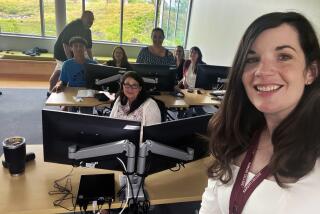Panel Proposes Opening the Tomb of Unknowns
- Share via
WASHINGTON — A Pentagon study group on Monday proposed opening the Tomb of the Unknowns at Arlington National Cemetery to investigate with DNA testing whether unidentified remains there are those of a Vietnam-era Air Force pilot.
After four months of deliberation, the panel said the testing probably would succeed in determining whether six bones in the revered crypt belong to 1st Lt. Michael J. Blassie. The tests should be performed, the panel said, to bring certainty to Blassie’s family, which has been unsure of his fate in the 26 years since his A-37B fighter plane was downed by ground fire near An Loc, Vietnam.
Defense Secretary William S. Cohen said he is reserving a final decision on the recommendation until he has heard from Pentagon lawyers. “My position is to wait until I get some counsel,” Cohen said during an appearance on Capitol Hill.
Despite Cohen’s hesitation, Blassie’s younger brother said that the family is pleased with the course of the Pentagon’s deliberations. “We’re very encouraged,” said George Blassie, 36, who lives in St. Peters, Mo. “We believe the final decision will be to disinter the remains for testing.”
Sources close to the issue speculated that Cohen was holding back on a decision to gauge any opposition that might emerge to opening the crypt.
So far, however, little has been visible. Most groups representing veterans and families of Vietnam War service members have weighed in on the side of disinterring the remains from the marble vault. “They’re moving in the right direction,” said Phil Budahn, spokesman for the American Legion, which has argued that the tomb should be opened if there is evidence to justify such a step.
The remains were entombed in 1985 at a ceremony presided over by President Reagan, a ceremony that closed a decade’s search for a Vietnam-era unknown. Separate crypts hold remains of unidentified service members from World War I, World War II and the Korean War.
*
Since 1994, however, some veteran activists have contended that the Pentagon knowingly overlooked evidence that the remains were Blassie’s to satisfy political pressure to add an “unknown” from the Vietnam War.
They have asserted that some clues found with the bones--including a military ID card and the remnants of an A-37 ejection seat and a flight suit--made a strong case that the remains were Blassie’s. They pointed out that the remains were first identified as probably belonging to Blassie but were subsequently tagged “unidentified.”
The Pentagon panel sought to rebut allegations that the military was motivated by expediency. It pointed out that evidence collected by Vietnamese forces at the crash site after Blassie’s downing seemed to indicate that the four ribs, pelvic fragment and right humerus were not his and could have belonged to any of eight Air Force and Army fliers who had been downed in the area.
Tests of these remains indicated that the deceased had Type O negative blood, while Blassie’s was A positive. And the analysis also suggested that the bones might belong to a flier of a different age and height than Blassie.
In their report, members of the study committee concluded that there was “no reason to question” the decision to choose the remains to be put in the tomb. “Given the limited technology at the time and the information available, the . . . remains were at that point unidentifiable,” the report said.
Though the Pentagon general counsel apparently has not offered his opinion, the study group also found no legal obstacle to opening the crypt. It found that there was no law or federal regulation governing disinterment and that the decision lies entirely in the hands of the Defense secretary.
More to Read
Sign up for Essential California
The most important California stories and recommendations in your inbox every morning.
You may occasionally receive promotional content from the Los Angeles Times.










